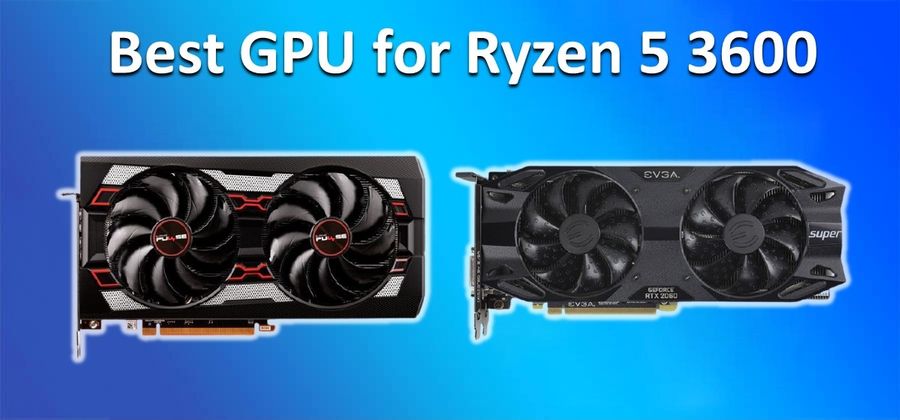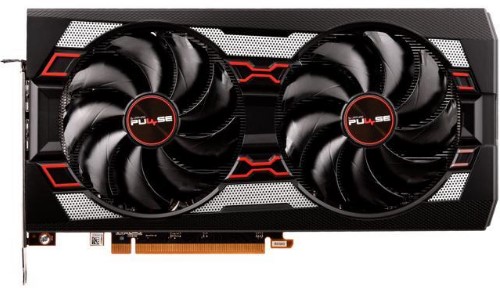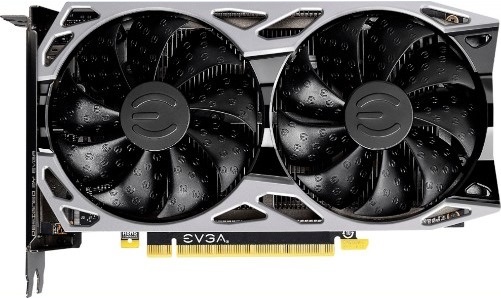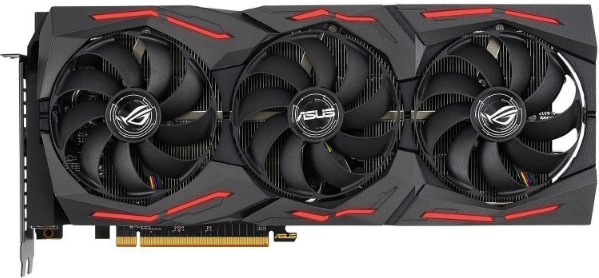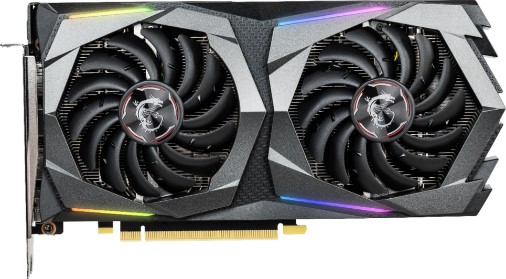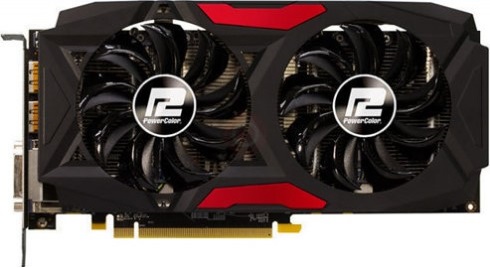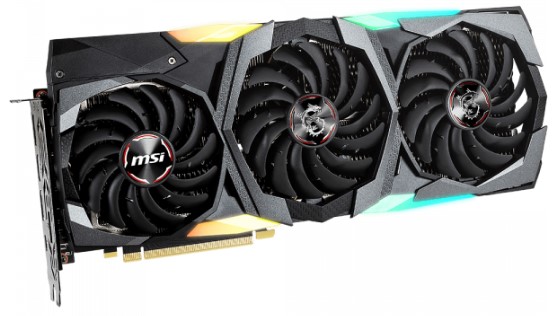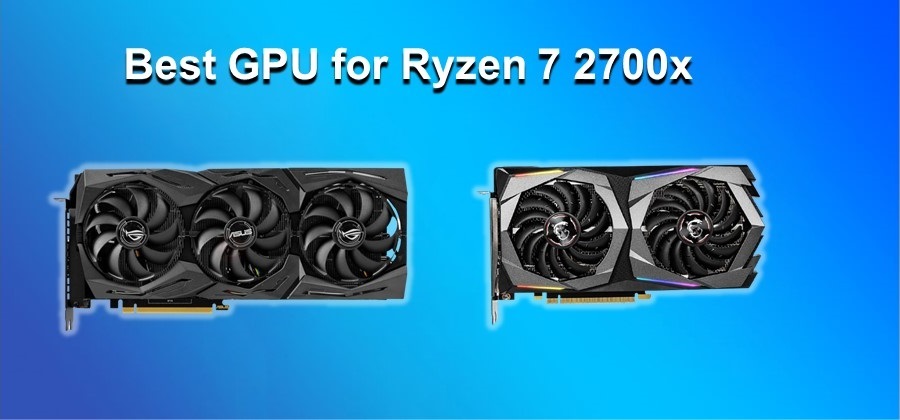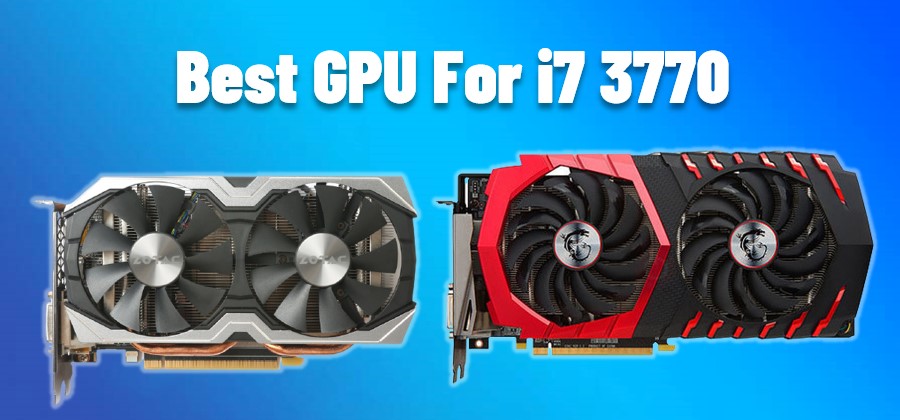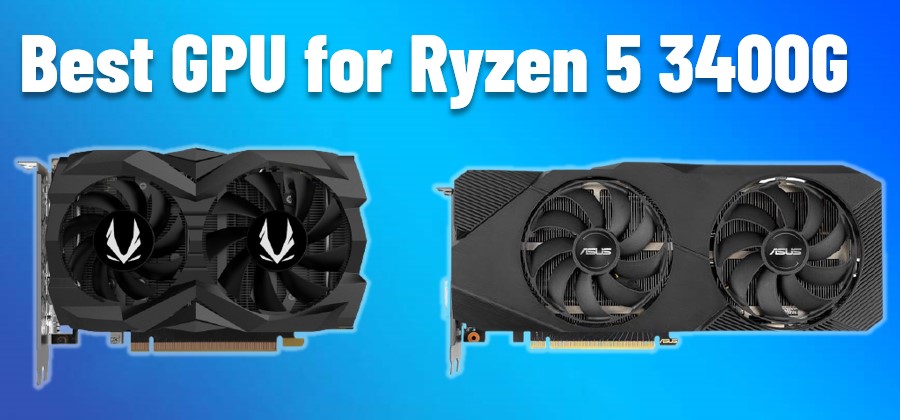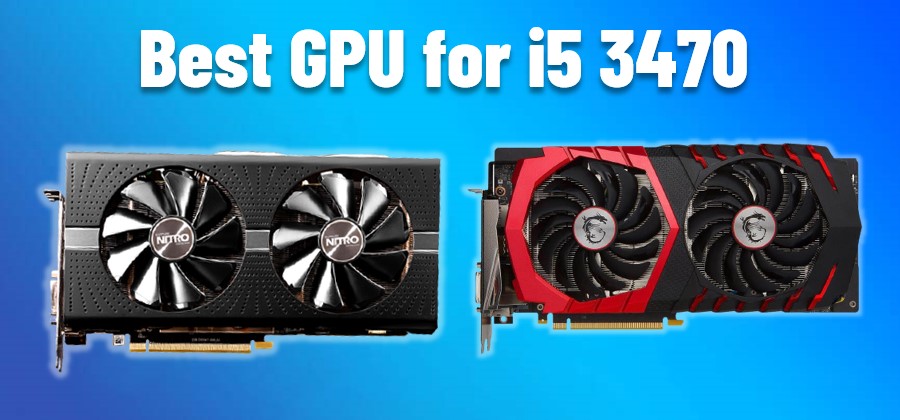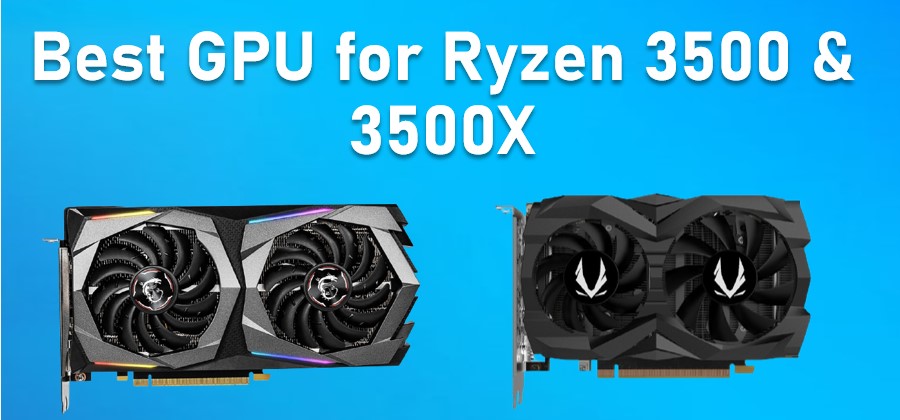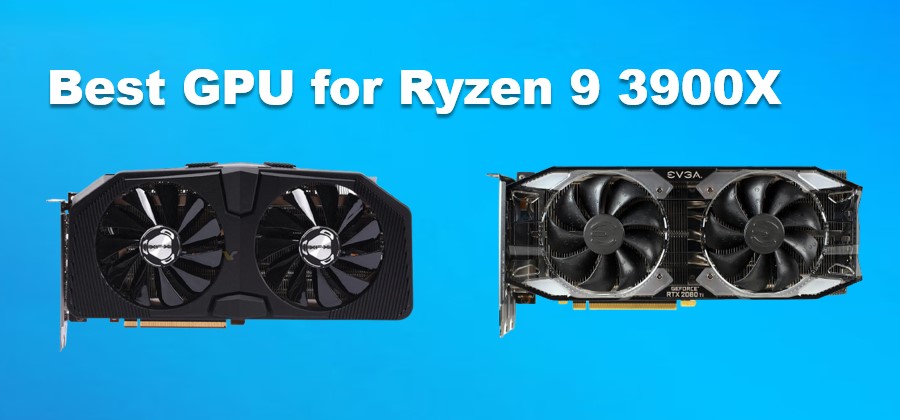6 Best GPU for Ryzen 5 3600
| Interface | PCIe 4.0 X16 |
| I/O Ports | 1 x HDMI, 3 x DP |
| Boost Core Clock | 1925 MHz |
| Form Factor | Triple-slot with dual-fan design |
| Memory Clock | 14000 MHz effective |
| Memory Size | 8 GB |
| Cores | 2304 |
|
SAPPHIRE PULSE Radeon RX 5700 XT BE is a well-balanced graphics card variant that does not tend to go over the board and yet offers great performance. This graphics card is priced lower than most flagship variants since it is not a flagship variant, however, the performance of this graphics card is quite similar to many flagship variants.
We saw a great change in the design of SAPPHIRE PULSE variants with the release of RDNA 1.0 architecture and surely this design feels better than the last one, which was getting a bit dated. The Black Edition of the PULSE variant has more of its body covered in black color, replacing the red color especially, which gives it a sophisticated look. It is not the longest graphics card variant but it still measures at 10 inches.
The cooling solution of this graphics card is much larger than the previous generation PULSE variants that we saw, like in the RX 590 PULSE, etc. It is a thick graphics card, having a triple-slot form-factor, and uses two fans at the front for cooling. The fans of this graphics card are similar to that of the previous generation, so do not expect any kind of improvement in noise or cooling due to fans.
The back-plate of the graphics card has the “Pulse” logo in gray color and it has a lot of vents so that the cooling does not get affected due to blocked airflow. The cooling pipes can be seen at the top of the graphics card while RGB lighting is also present at the top where it lights up the SAPPHIRE logo. The I/O of the graphics card offers 1 x HDMI port and 3 x DP port, which ensures that you will be able to run a multi-monitor setup easily and effectively.
The base clock of the graphics card is 1670 MHz while the boost clock is 1925 MHz, which is only 1% faster than the reference variant, although the overclocking is completely dependent on the user. The graphics card offers 2560 shader processing units, which although seems to be a small improvement over the RX 590 graphics card from the previous generation, the difference in core clock results in a great performance improvement.
Related: Best GPU for Ryzen 7 3700X
The graphics card comes with 160 Texture Mapping Units and 64 Render Output Units while the cache size is 4 MB. The memory of the graphics card has been upgraded from the previously used GDDR5 in the previous generation and RX 5700 XT comes with GDDR6 memory, which is much faster than the GDDR5 memory. The memory is clocked at 1750 MHz, leading to an effective memory clock rate of 14 Gbps, which is one of the reasons for the massive performance improvement from the previous generation, as it leads to 448 GB/s of memory bandwidth.
The lithography of this graphics card is 7nm, which is why it is much more efficient than the previous generation graphics card, and RX 5700 XT has a TDP of 225 watts, where SAPPHIRE PULSE Radeon RX 5700 XT requires 1 x 8-pin power connector and 1 x 6-pin power connector.
The performance of SAPPHIRE PULSE Radeon RX 5700 XT is great in almost any game as long as your screen resolution is not 4K and that is why a lot of people are buying this graphics card to use in their rigs with 1440P high-refresh-rate displays. You can also use this graphics card for high-end competitive gaming if you own one of those 240-Hz 1080P monitors and both this graphics card and AMD Ryzen 5 3600 seem to be highly suitable for this kind of gaming.
Conclusion:
SAPPHIRE PULSE Radeon RX 5700 XT is one of the best graphics cards that you can buy right now before the release of the RX 6000-series graphics card and unlike NVIDIA, whose most of the 3000-series graphics cards are out of stock, you won’t be suffering from issues with respect to availability.
For someone who wants to own a high-end graphics card that would allow you to withstand the upcoming three to four years of gaming with ease, SAPPHIRE PULSE Radeon RX 5700 XT seems like a perfect choice, thanks to its great price to performance ratio and ever-improving driver support, although you will not be getting any kind of NVIDIA exclusive features like Ray-Tracing, etc.SAPPHIRE PULSE Radeon RX 5700 XT B is Best GPU For Ryzen 5 3600 due to its powerful specs.
Pros
- One of the best-valued graphics cards right now
- Not a bulky design
- Sophisticated looks
Cons
- No Ray-tracing or other NVIDIA exclusive features.
| Interface | PCIe 3.0 X16 |
| I/O Ports | 1 x DVI, 1 x HDMI, 1 x DP |
| Boost Core Clock | 1755 MHz |
| Form Factor | TDual-slot with dual-fan design |
| Memory Clock | 14000 MHz effective |
| Memory Size | 6 GB |
| Cores | 1920 |
|
EVGA GeForce RTX 2060 SC Ultra belongs to the RTX 2000-series graphics cards by NVIDIA and this was the cheapest graphics card at that time that you could get your hands on if you want Ray Tracing and other RTX-specific features. The performance of this graphics card is lower than the likes of RX 5700 XT or even the RX 5700 but the exclusive features of NVIDIA or simply the choice of more vendors sometimes makes it inevitable to choose NVIDIA graphics cards.
To be honest, we did not like the designs of the RTX 2000-series graphics cards by EVGA other than the tri-fan variants, and as per our perspective, the GTX 1000-series graphics card by EVGA did look a lot better than the RTX 2000-series ones. One of the reasons for this is that the 2000-series graphics cards felt a bit raw in design while the previous generation cards provided uniformly-shaped designs.
Here, in the EVGA GeForce RTX 2060 SC Ultra Gaming graphics card, the wave-like design of the fan-shroud feels a bit ugly and since the height of the graphics cards is regular as well, the graphics card looks very lengthy. By form factor, this graphics card is a dual-slot dual-fan card, where the graphics card is not very long as well, at 10.6 inches and your casing probably will support this graphics card, as long as your motherboard does not pose any blockage to the PCI-E slot.
The fans of all the EVGA graphics cards got changed in this generation and it seems like the newer aggressive design of the fans makes them more powerful, although it could have a negative impact on the acoustic performance of the graphics card.
The boost clock of the graphics card is 1755 MHz, although due to NVIDIA GPU Boost technology, you are likely to have clock rates around 2000 MHz if you are not suffering from any kind of thermal or power throttling issues. The graphics card offers 1920 shader processing units, which is the same number of units that were present in the GTX 1070 from the previous generation. Ultimately, due to better driver support, newer architecture, and better memory performance, this graphics card performs better than the GTX 1070.
Related: Best GPU for Ryzen 7 2700X
The graphics card has 120 Texture Mapping Units and 48 Render Output Units. Moreover, the graphics card provides 240 Tensor cores and 30 RT cores. Tensor cores can be used in various types of machine-learning applications while the RT cores are specifically used for real-time Ray Tracing. As for the I/O, the graphics card comes with 1 x DVI port, 1 x HDMI port, and 1 x DP port.
The graphics card comes with 6 GB of GDDR6 memory, which is a bit lower than the RX 5700 XT and the memory bus width of this graphics card is lower as well, at 192-bits, which is why, despite having similar effective memory speed, the memory bandwidth of this graphics card is 336 GB/s.
This graphics card is based on the Turing architecture, which was slightly more efficient than the Pascal architecture and NVIDIA RTX 2060 graphics card has a low TDP of 160 watts, which is why this graphics card does not run very hot under full load and is likely to stay under 75 degrees even if the fans are running at low speeds. As per the power requirements, it requires only a single 8-pin power connector, which is more than enough for this graphics card, even if you overclock it.
For gaming, it seems like you might not be able to run some AAA games at ultra settings on 1440p with liquid-smooth FPS but reducing the settings or resolution will surely help and you won’t have to upgrade your graphics card for at least two years if you own a 1440P monitor.
Conclusion:
EVGA GeForce RTX 2060 SC Ultra Gaming graphics card seems a be a great option for those people who want NVIDIA-exclusive features whether that be Ray Tracing or NVIDIA G-Sync or whatever. The performance of this graphics card is although lower than the similarly priced AMD Radeon RX 5700, the reliability of NVIDIA drivers and unique features force some users to buy only from the green team.
Pros
- Ray Tracing and NVIDIA G-Sync support
- Solid performance for 1080P and 1440P gaming
Cons
- Not the best-looking variant
| Interface | PCIe 4.0 X16 |
| I/O Ports | 1 x HDMI, 3 x DP |
| Boost Core Clock | 1750 MHz |
| Form Factor | Triple-slot with triple-fan design |
| Memory Clock | 14000 MHz effective |
| Memory Size | 6 GB |
| Cores | 2304 |
|
ASUS is a company that seems to be accomplishing some awesome goals that none could have dreamed of in the past and it looks like it’s among the favorite companies of enthusiasts whether you talk about graphics cards, motherboards, laptops, or any other hardware components.
One of the best products of the company is its graphics cards and personally, we value its graphics card quite higher than other vendors due to various factors such as aesthetics, durability, and overall reliability. ASUS ROG STRIX models have always been the flagship series in most of their products and the same is the case with graphics cards. ASUS ROG STRIX variants are more expensive than most of the other variants and provide top-notch performance as well. ASUS ROG STRIX Radeon RX 5600 XT TOP Edition is the finest variant that you could get from ASUS and this graphics card has some serious cooling power under the hood, despite the fact that Radeon RX 5600 XT is not a high-end graphics card chip.
We have always loved the design of the ROG STRIX models and the same is the case with ROG STRIX RX 5600 XT TOP Edition. The design of this graphics card is similar to some other graphics card models like ROG STRIX RX 2070, 2080, or even the 2080 Ti. The heat-sink inside is definitely different, which is why the cooling performance of this graphics card is, of course, nowhere close to what the cooling performance of a ROG STRIX 2080 Ti would be but the outer design is almost the same.
The complex-looking fan-shroud here looks rather interesting, unlike the EVGA graphics card, and RGB lighting at various parts of the front surely looks fantastic. The graphics card does come with a pretty back-plate and in fact, this is one of the only graphics card variants of RX 5600 XT that provides RGB lighting at the back-plate as well. There is the ROG logo at the back-plate where RGB lighting shines spectacularly. So, overall, you are going to see RGB lighting no matter whether you use the graphics card in a vertical mounting position or horizontal mounting position.
The graphics card chip itself is considered mediocre as of now, and one of the reasons for this is that we are seeing various newly-released graphics card in the market such as RTX 3070 and 3080, etc. The base clock of the graphics card is 1400 MHz while its boost clock is 1750 MHz. By architecture, this graphics card is the same as an RX 5700 whose one fourth memory part is cut off and the clock rates are reduced.
There are 2304 shader processing units in this graphics card while there are 144 Texture Mapping Units and 64 Render Output Units. The memory performance of this graphics card is the same as that of an RTX 2060, as it offers 6 GB VRAM as well in combination with 14 Gbps of effective memory speed and a 192-bit memory bus, leading to a memory bandwidth of 336 GB/s. This makes the performance of this graphics card similar to the performance of NVIDIA GeForce GTX 1080 which was one of the best graphics cards from the 1000-series. The I/O of the graphics card offers 3 x DP ports and 1 x HDMI port.
The thermals of this particular variant are really impressive, as expected from a triple-fan cooling solution by ASUS. Moreover, acoustic performance is much better than competitors, which makes it great for those who like to work in calm environments.
Conclusion:
Overall, ASUS ROG STRIX Radeon RX 5600 XT TOP Edition is one of the best graphics cards for those who are looking to max-out AAA games on their 1080P monitors and don’t want to upgrade for at least two years. This graphics card is surely not so powerful to run games at 4K but you can still enjoy relatively old games at 4K resolution as long as you don’t crank the settings too high.
Pros
- One of the best-looking graphics cards
- Supreme cooling performance
Cons
- Not for high-refresh-rate 1440P or 60-Hz 4K gaming
| Interface | PCIe 3.0 X16 |
| I/O Ports | 1 x HDMI, 3 x DP |
| Boost Core Clock | 1925 MHz |
| Form Factor | Dual-slot with dual-fan design |
| Memory Clock | 12000 MHz effective |
| Memory Size | 6 GB |
| Cores | 1536 |
|
MSI is one of the only companies that give tough competition to ASUS when it comes to graphics cards and the history of MSI is quite similar to that of ASUS, with almost similar product categories. MSI designs graphics cards for both the green team and the red team, which is why, just like ASUS, and one of the most popular series by MSI goes by the name of GAMING X.
Yes, MSI GAMING X has become a popular name in graphics card variants and this variant usually provides high performance while being priced lower than the flagship variants by other companies like ASUS or GIGABYTE. MSI GeForce RTX 1660 Ti is quite a cheap graphics card comparing to the likes of RTX 2070, or 2080, etc. It is targeted towards mid-range gamers who are willing to reduce the visual settings in games in order to achieve liquid-smooth FPS.
The design of this graphics card is similar to that of some of the better RTX-series graphics cards like RTX 2060 or RTX 2070. Surely, it is one best graphics card for Ryzen 5 3600. The black and silver-colored theme looks really cool and this makes this graphics card one of the most jaw-breaking components in your rig, especially if your rig has RGB lighting as well.
There is RGB lighting at the front as well as the top of the graphics card, which can be customized through the software application and can be synchronized with other hardware components as well. The graphics card feels massive and the main reason for this is its height, although it is still shorter than the likes of ROG STRIX tri-fan graphics card variants.
The graphics card offers 1536 shader processing units in combination with 96 Texture Mapping Units and 48 Render Output Units. A particularly interesting thing to note here is that this graphics card does not provide Tensor or RT cores, which is why it does not provide RTX features despite being a graphics card having the Turing architecture. Still, you can take advantage of NVIDIA GSync or CUDA technology, which might interest some people.
The base clock of the graphics card is 1500 MHz while the boost clock is 1875 MHz. The graphics card comes with 6 GB of VRAM, having a memory bus of 192-bits and an effective memory speed of 12 Gbps, which leads to a memory bandwidth of 288 GB/s. This makes this graphics card better than the likes of GTX 1070 while it’s still slower than GTX 1080. The TDP of this graphics card is around 130 watts, which is why it does not run as hot as high-end graphics cards and you won’t notice temperatures above 70 degrees most of the time.
Conclusion:
MSI GeForce GTX 1660 Ti GAMING X is a graphics card that is best-suited for those people who are not willing to spend a lot of money on computer hardware but still they want a solid graphics card that offers satisfactory performance while not compromising on the looks by any means. This graphics card, although, is not so future proof and you might notice stuttering in the upcoming AAA games at ultra settings on 1080P resolution.
Pros
- Shiny looks attract a lot of customers
- Quite low TDP for its performance
| Interface | PCIe 3.0 X16 |
| I/O Ports | 1 x DVI, 1 x HDMI, 3 x DP |
| Boost Core Clock | 1350 MHz |
| Form Factor | Triple-slot with dual-fan design |
| Memory Clock | 8000 MHz effective |
| Memory Size | 8 GB |
| Cores | 2304 |
|
PowerColor is a company that tends to offer cheaper variants compared to other vendors and that is why many people opt for its products. The two most popular series by the company go by the names of Red Devil and Red Dragon, where Red Devil is the flagship series and Red Dragon offers a rather balanced profile.
PowerColor Radeon RX 580 Red Dragon is quite an old graphics card as of now since it was released back in 2017. The performance of this graphics card is lower than the other graphics cards on the list and that makes it great for those people who are looking to buy a graphics card that can provide stable FPS even if they have to reduce the graphical settings.
The design of this graphics card is quite ugly and that is mainly due to the absence of material in the fan-shroud. Moreover, it does not provide any kind of RGB lighting, etc. but the red part does try to compensate for that. Thankfully, the graphics card does come with a back-plate, so you are not going to have a sagging GPU in your case.
The graphics card has a boost core clock of 1350 MHz, which is the main reason behind its much lower performance than other graphics cards on the list. The memory performance of the graphics card is somewhat sluggish as well, compared to today’s standards, as it has a memory bandwidth of 256 GB/s, although the 8 GB of VRAM seems great for today’s games.
The performance of this graphics card is slightly lower than that of NVIDIA GeForce GTX 1070, which is why you should be fine with most of today’s games at 1080P resolution with high settings but do not expect this graphics card to run upcoming games at liquid-smooth FPS with high settings.
Conclusion:
PowerColor Red Dragon RX 580 is a graphics card that is surely much older than the likes of GTX 1650 or 1660 but thanks to the ever-improving drivers of AMD, this graphics card has kept up with the newer graphics cards and it is still a fine card for those people who are willing to spend a low amount on their PC but still want satisfactory gaming experience.
Pros
- Offers a large amount of VRAM
- Comes at a cheap price
Cons
- Has a high TDP compared to similarly-performing cards
- Ugly looks compared to the latest variants
| Interface | PCIe 3.0 X16 |
| I/O Ports | 1 x DVI, 1 x HDMI, 3 x DP |
| Boost Core Clock | 1350 MHz |
| Form Factor | Triple-slot with dual-fan design |
| Memory Clock | 8000 MHz effective |
| Memory Size | 8 GB |
| Cores | 2304 |
|
Release in the last quarter of 2018, the MSI GeForce RTX 2080 Gaming X Trio is still one of the most powerful GPU in the market; it gives out a top-notch gaming performance and lives right to the expectation of the current next-gen visual power. A couple of years the RTX 2080 is still as capable as it was before, and stands right up to par in the RTX lineup. Nvidia has been dropping quite a lot of high-end revolutionary GPUs, all equipped with the new RTX technology that brought a significant visual evolution in the next-gen gaming industry. The first time Nvidia introduced this brilliant technology, was with the all-powerful RTX 2000 series. A technical showdown against its competitor, speeding up, the evolution of the graphics, and giving the absolute bang for the buck, these RTX variants are quite a lot to count, but among the best is the MSI GeForce RTX 2080 Gaming X Trio.
When it comes to specifications, the MSI GeForce RTX 2080 Gaming X Trio is adequately equipped for the current next-gen visual power, and can still carry itself gracefully. This 8GB GDDR6 RTX 2080 goes with a boost clock of 1860Mhz and a typical 14GBps memory speed. The RTX technology is surely a huge plus on this one, it further enhances the visual quality, making it even more beautiful with real-time ray tracing than the actual specifications could exhibit. The Turing architecture steps it all up by properly infusing the real-time ray tracing, artificial intelligence, and programmable shading, giving the final touches of power that makes it a healthy adversary for the competition.
The thermal performance of the NVidia GPUs is always quite satisfactory, but paired with MSI, things go above and beyond. The MSI GeForce RTX 2080 Gaming X Trio features the renowned TRI-Frozr thermal design. The TRI-Frozr design utilizes three award-winning TORX 3.0 fans with Double Ball Bearings and a GPU design that aims to provide excellent heat dissipation with optimized heatsink and aerodynamics techniques that further enhances the cooling efficiency of the GPU. The TORX fans have both traditional and dispersion fan blades to perfectly process the airflow for quite a satisfactory thermal performance. These fans not only do good but also looks good, giving the GPU a beastly look that is deservedly required.
With a triple fan design, and its brilliant support for Directx 12, and super smooth 4k gaming, that you can easily take up to 8k if your build allows; the MSI GeForce RTX 2080 Gaming X Trio requires a recommended 650W PSU to fulfill its power consumption needs of 260W on average. You get three V1.4a Displayport, a single HDMI 2.0b that is capable of powering 4k@60Hz, and a USB Type-C for more contemporary support.
The range of customization is also quite vast when it comes to GPU manufactured by MSI. On this one, you get a wide range of software to do customization to achieve more personalized results; Whether it's overclocking to juice out the maximum performance or just a more synchronized look of the already installed RGB lights - via Dragoncenter, you get the ultimate control of this GPU on just a few clicks.
Not only is it designed to carry out an excellent thermal performance but also to fulfill your aesthetics. The classy back-plate is quite literally cool in every sense. The RGB lights are placed nicely at the sides and are not too flashy for anyone's taste, and you can tune them with your mood with the MysticLight application. The dark aesthetics are fairly decent and the dark of the fans sits perfectly between.
Conclusion:
The MSI GeForce RTX 2080 Gaming X Trio is expensive but quite capable for next-gen gaming. It is one of the most powerful GPU in the RTX line-up, and it was indeed a revolutionary step at the time it was released. It still goes perfectly, for a super smooth 4k gaming performance with stunning visuals. The cooling performance is extraordinary thanks to MSI's Tri-Frozr design. The price is a huge con because the Turing architecture might be powerful, but even at 14nm, it is fairly old compared to what the competitors are offering. The length issue is not the problem because the targeted audience usually has enough housing space in their gaming cases. Other than that, the performance is satisfactory, the under-utilization of Ray-tracing and DLSS is a minor optimization issue and its impact on performance is insignificant.
Pros
- Excellent Thermal Performance
- The factory overclocked settings are nice
- Dual eight-pin power connectors and a higher power rating
- Wide-range of customization
- Deep-learning feature-set
Cons
- Too long for most average cases
- The Ray-tracing and DLSS features are not as utilized up to the bar, like with all RTX cards
- Expensive
